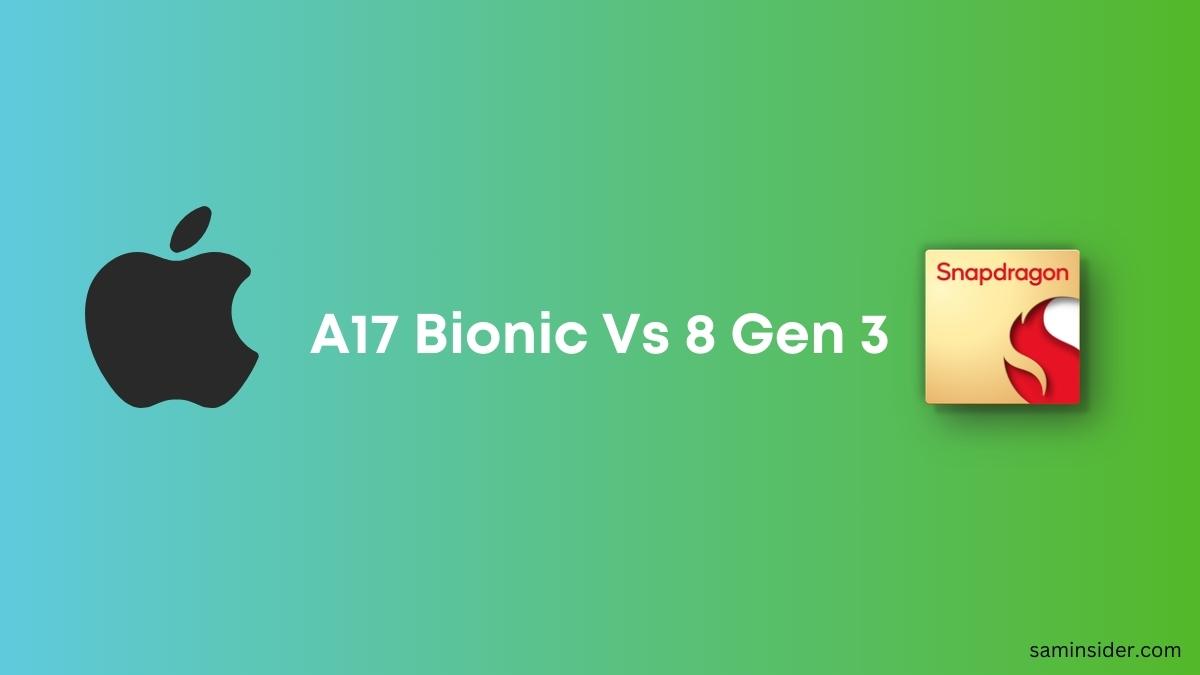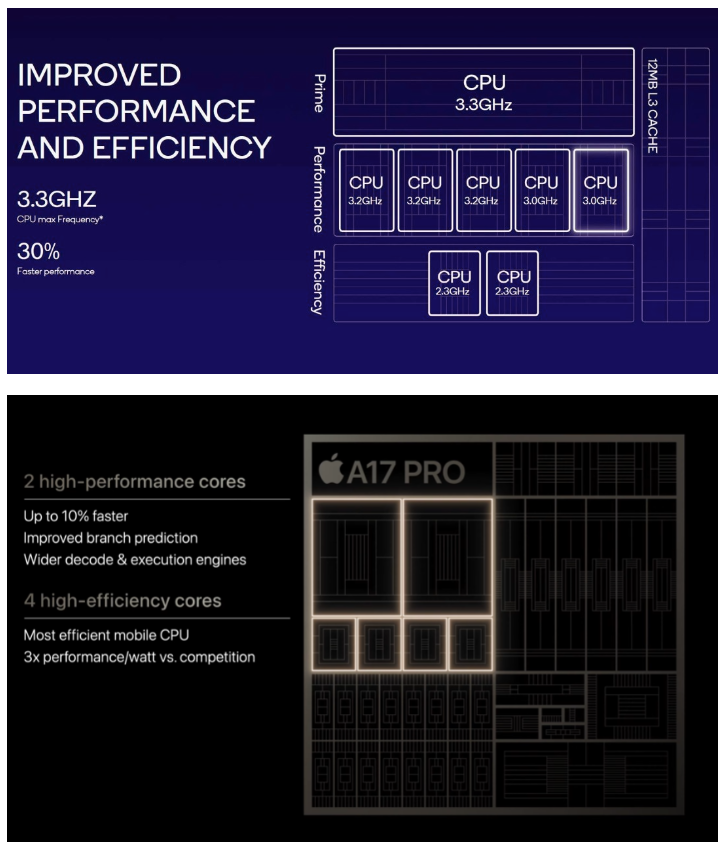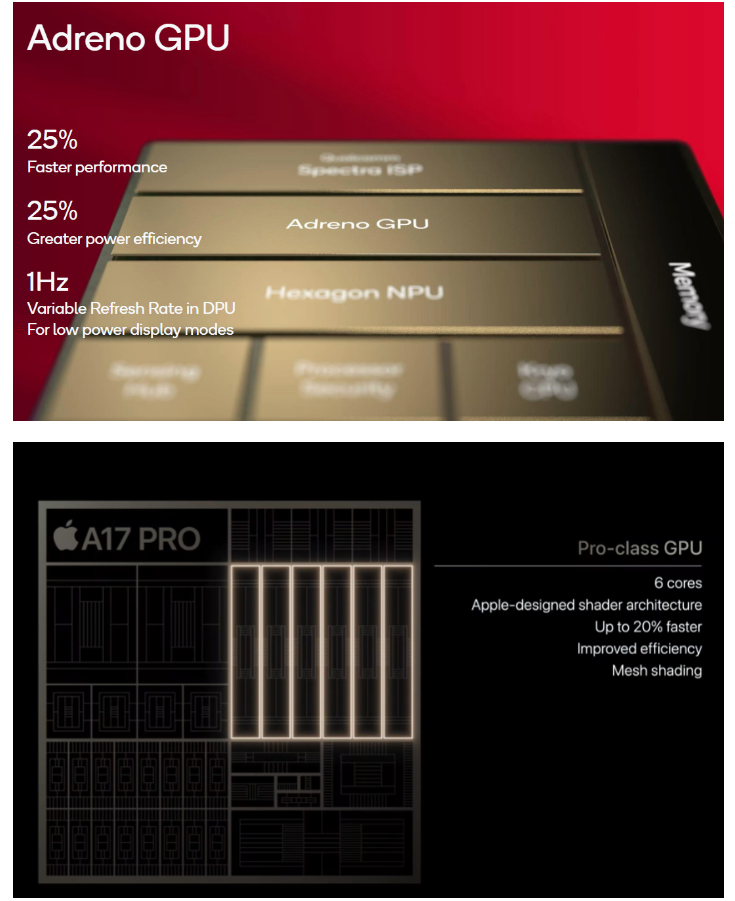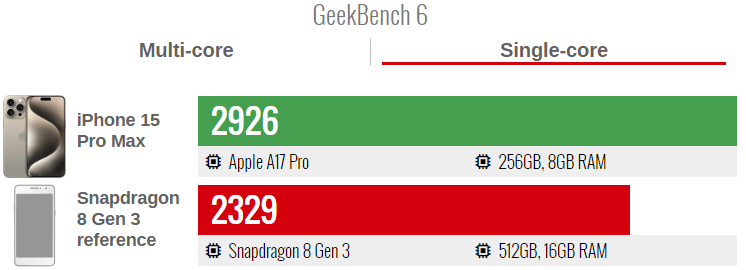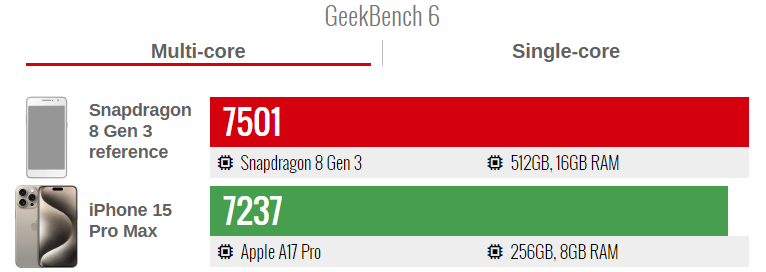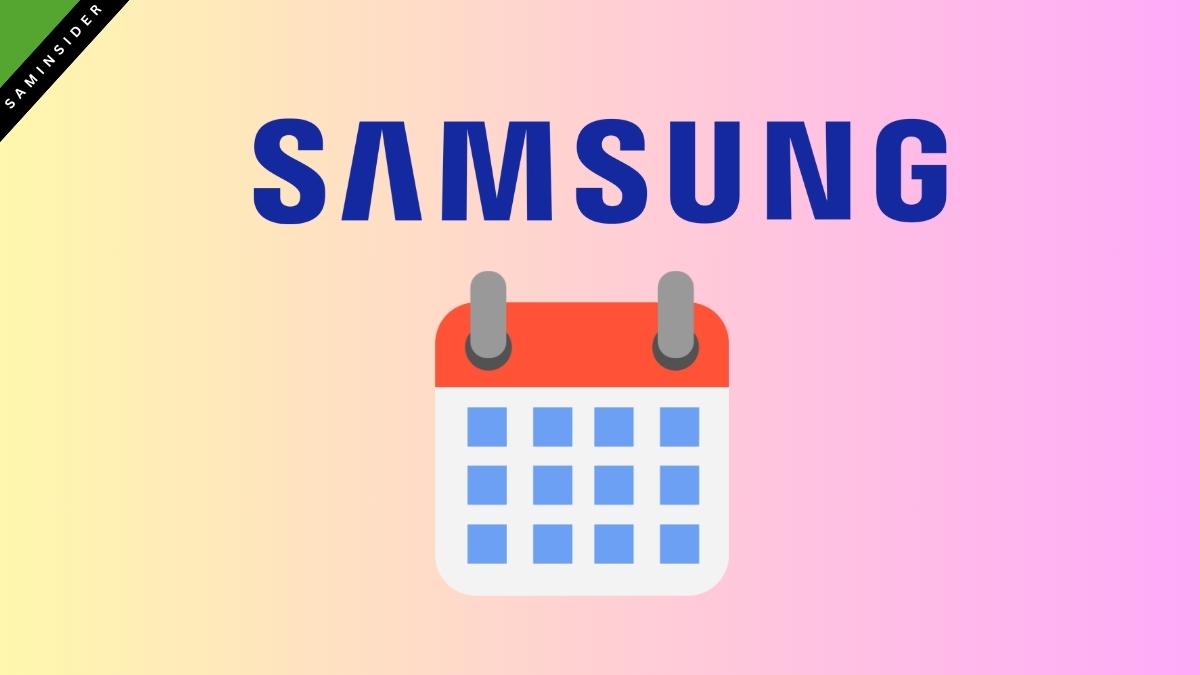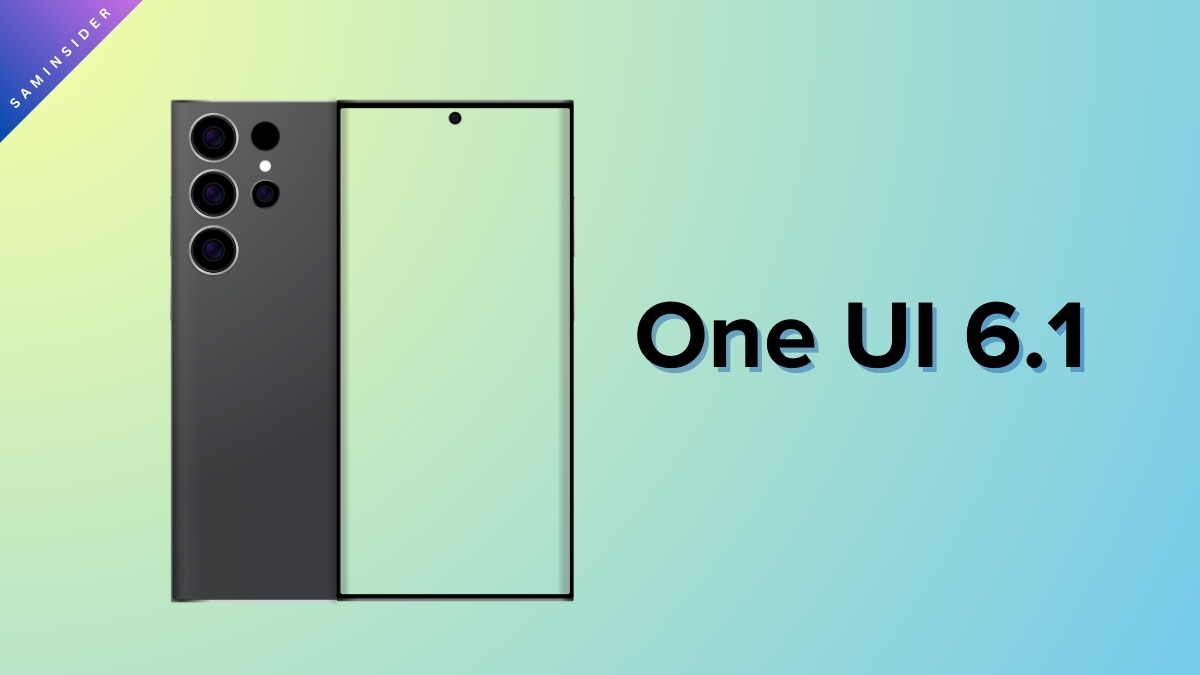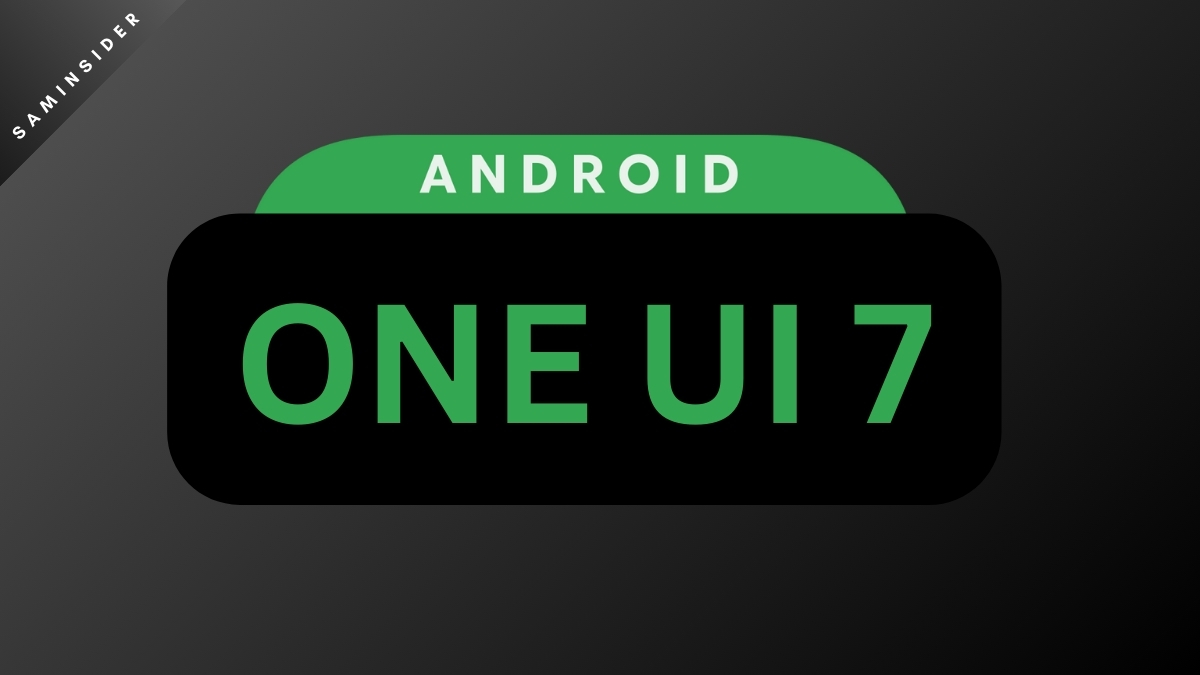After the Apple event, we learned that Apple’s A17 Pro now brings a breakthrough 3nm fabrication process to iPhones, which is a considerable efficiency bump. Since Apple bought a majority of TSMC’s 3nm share, Qualcomm officially uses the TSMC 4nm fabrication for the 8 Gen 3.
In this theoretical comparison, we will assess the key differences between the 8 Gen 3 from Qualcomm and Apple’s A17 Pro. Apple announced the A17 Pro on 12 September, alongside the iPhone 15 Pro/ Max. Like last year, Apple is sticking with the previous chip for the vanilla models instead of giving a new chip to all the models.
The 8 Gen 3 scores between 6500 and 7000 points in the multi-score Geekbench test, and that’s close to Apple’s CPU on the A16. Samsung will probably partner up with Qualcomm for a better version of the 8 Gen 3. We expect higher clock speeds for better peak performance on the upcoming S24 and Z Flip 6/ Fold 6 series.
1. CPU comparison
Apple uses a 6-core CPU cluster for the A17 Pro. The maximum clock speed of the A17 Pro is now 3.78 GHz, up from the 3.46 GHz for the A16 Bionic SOC. It uses TSMC’s performance-centric N3B fabrication. N3B has a lower yield but delivers better performance. The N3E processing is more standard and has better efficiency, and this is what the vanilla models could get next year.
The 8 Gen 3 has a max clock speed of 3.3 GHz. Apple still maintains a CPU lead thanks to more transistors in the same area thanks to a smaller 3nm node. The Snapdragon 8 Gen 3 uses TSMC’s N4P 4nm process node rather than the company’s next-generation 3nm node used for the A17. However, as per tipster @Tech_Reve, Qualcomm’s flagship chipset achieves 30 percent greater power efficiency than the A17 Pro in the iPhone 15 Pro models, though improved efficiency often requires tradeoffs in peak performance. These reports were proven with tests from the new Xiaomi 14 and 14 Pro.
Even built on a slightly older process, Qualcomm is making significant efficiency gains with the Snapdragon 8 Gen 3 to rival Apple’s A17 Pro built on the bleeding edge 3nm node. It has one prime core, Cortex-X4, at 3.3 GHz, five Cortex-A720 performance cores clocked at up to 3.2 GHz, and two efficiency/ small cores clocked at up to 2.3 GHz.
Samsung is getting an exclusive 8 Gen 3 for Galaxy chipset. It will feature a boost to both the CPU and GPU clock speeds. The Cortex-X4 is 3.3 GHz for the regular 8 Gen 3, but the Prime core is 0.1 GHz higher at 3.4 GHz.
The other cores are clocked very similarly and negligibly lower. The three Cortex-A720 cores are clocked at 3.15 GHz instead of 3.2 GHz, and the other two Cortex-A720 cores are clocked at 2.96 GHz instead of 3 GHz. Finally, the last Cortex-A520 efficiency cores clocked slightly lower at 2.27 GHz instead of 2.3 GHz.
Update: Snapdragon 8 Gen 3 boasts a 30% better power efficiency compared to the A17 Pro.
The performance gap in GB6 multi-core benchmark scores between Snapdragon and Apple Silicon is narrowing, and the Snapdragon 8 series GPU's peak performance surpasses Apple's. In 2022, there…
— Revegnus (@Tech_Reve) October 7, 2023
2. GPU comparison
The Snapdragon 8 Gen 2’s GPU already has a considerable lead over the A16 Bionic. The A16 Bionic SOC was supposed to get a much better GPU, but it was discarded due to heating issues. What we got as a result wasn’t much of an improvement from the A15’s 5-core GPU.
The A17 Pro features a new 6-core GPU, which is a major improvement. Now, the number of GPU Cores of the A17 could finally match the CPU cores. Many Android phones benefit from additional cooling for better thermal control, but the A17 Pro relies on body conduction for thermal dissipation.
The A17 Pro brings hardware-level Ray Tracing capability, and there are already some games supporting it. Apple’s demos showcase that they’re also working with developers about it. The 8 Gen 3 will enhance the efficiency of the GPU further, but they don’t have the same developer support. While some reports claim that the new GPU of the 8 Gen 3 is a new Android champ and that it’ll beat the A17’s GPU easily, we can’t tell since Apple’s developer environment is stronger.
The Snapdragon 8 Gen 3’s Adreno GPU will include support for real-time hardware-accelerated ray tracing with global illumination, Unreal Engine 5 Lumen Global Illumination and Reflections System, Snapdragon Game Super Resolution, Adreno Frame Motion Engine 2.0, and more.
The latest reports suggest that the 8 Gen 3 is a lot more efficient than the A17 Pro. It has a much better performance with regards to 3D Mark stress tests as well. The efficiency graph proves that it also draws less power than the A17 Pro.
The exclusive GPU for Samsung will also get a much higher clock speed. The regular Adreno 750 GPU of the 8 Gen 3 GPU has a clock speed of 770 MHz. Samsung’s GPU has a 1000 MHz- or 1 GHz clock speed.
3. ISP
The ISP is an important part of the chipset since it is responsible for the camera experience you get. Apple’s A17 Pro finally gets the new Smart HDR 5 standard. Apple’s ISPs are also highly well-tuned to videos. They effortlessly capture multiple exposures at double the frame rate and merge them for a smooth and well-exposed output. It also supports Log & ACES formats for better shadow and highlight preservation, and it’s a treat for professionals since the iPhone also supports 12-bit Dolby Vision HDR videos and Pro Res encoding format.
Snapdragon chips can shoot multiple exposures, but the output is seldom as good. Apple is still capable of 4K 30FPS cinematic mode video and 2.8K stabilized video, completely taking an edge.
However, the flexibility goes to Snapdragon chips historically. You get support for 200MP, higher-bit RAW capture, proper Pro Mode functionality, and more. We can’t conclude how the ISPs stack up against each other. Snapdragon even uses AI features to identify particular characteristics in photos and enhance them. They use semantic segmentation for better exposure and dynamic range overall. We don’t know what exclusive features these new ISPs will bring, so we can’t determine which one wins at the time of writing.
The Snapdragon 8 Gen 3 includes Qualcomm’s Spectra Image Signal Processor (ISP), which features a cognitive ISP and triple 18-bit ISPs. This allows for up to 36 MP triple camera capture at 30 FPS with Zero Shutter Lag (ZSL), up to 64+36 MP dual camera capture at 30 FPS with ZSL, and up to 108 MP single camera capture at 30 FPS with ZSL. The Spectra ISP also supports 8K HDR video capture + 64 MP photo capture at 30 FPS and 4K video capture at 120 FPS.
4. Benchmarks
In the Geekbench tests, an unknown 8 Gen 3 phone scored around 2,229 points on the single-core test and around 7,400 points on the multi-core test. The high multi-core score of approximately 7,501 points is enough to surpass the A17 Pro chip’s score, which scored around 7,237 points.
We have official Geekbench reports from phones like the Xiaomi 14 and Xiaomi 14 Pro. They use a slightly lower-clocked version of the 8 Gen 3. They still managed to score nearly 7000 points on the multi-core test and around 2000 on the single-core test.
However, the single-core score of 2,329 points does not seem likely to beat the iPhone 15 Pro’s single-core Geekbench score of around 2,926 points with its A17 Pro chip. So, while the Snapdragon 8 Gen 3 nearly matches the A17 Pro in multi-core processing power, it still falls short in single-core performance based on these early Geekbench results.
In AnTuTu 10, an 8 Gen 3 phone outperformed an A17 Pro by scoring 44% higher, with 2,139,281 points compared to 1,484,203 points.
Verdict
From what we know, Apple will mostly retain the lead in CPU performance since the software currently works the best with their chips- which they design. Apple could potentially improve its efficiency lead. Apple’s efficiency remains class-leading since their phones with ~4400 mAh batteries outlast several other 5000 mAh batteries.
If the 3nm efficiency boost is significant, the iPhone 15 series will be battery champs. Both have their own benefits for gamers. Qualcomm’s chips benefit from cooling systems that are physically better, but Apple benefits from excellent developer support. The ISPs will probably trade blows since they’re better at different things.
We’ll find out the exact CPU cluster configuration for the 8 Gen 3 and A17 in a few weeks, and we can then draw more conclusions. We have to mention that all the assumptions made in this article come from early leaks and rumors of the 8 Gen 3. None of this is confirmed, and it’s just to get a general idea of how these two chips might stack up against each other and what to expect.
